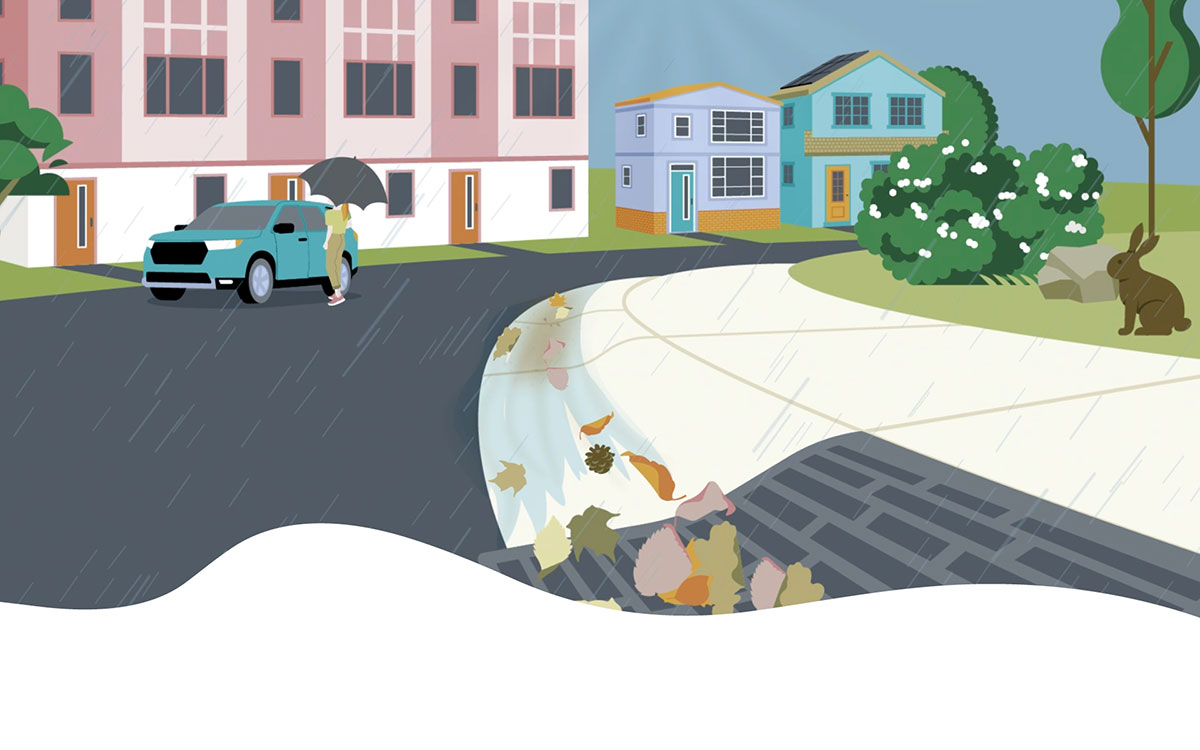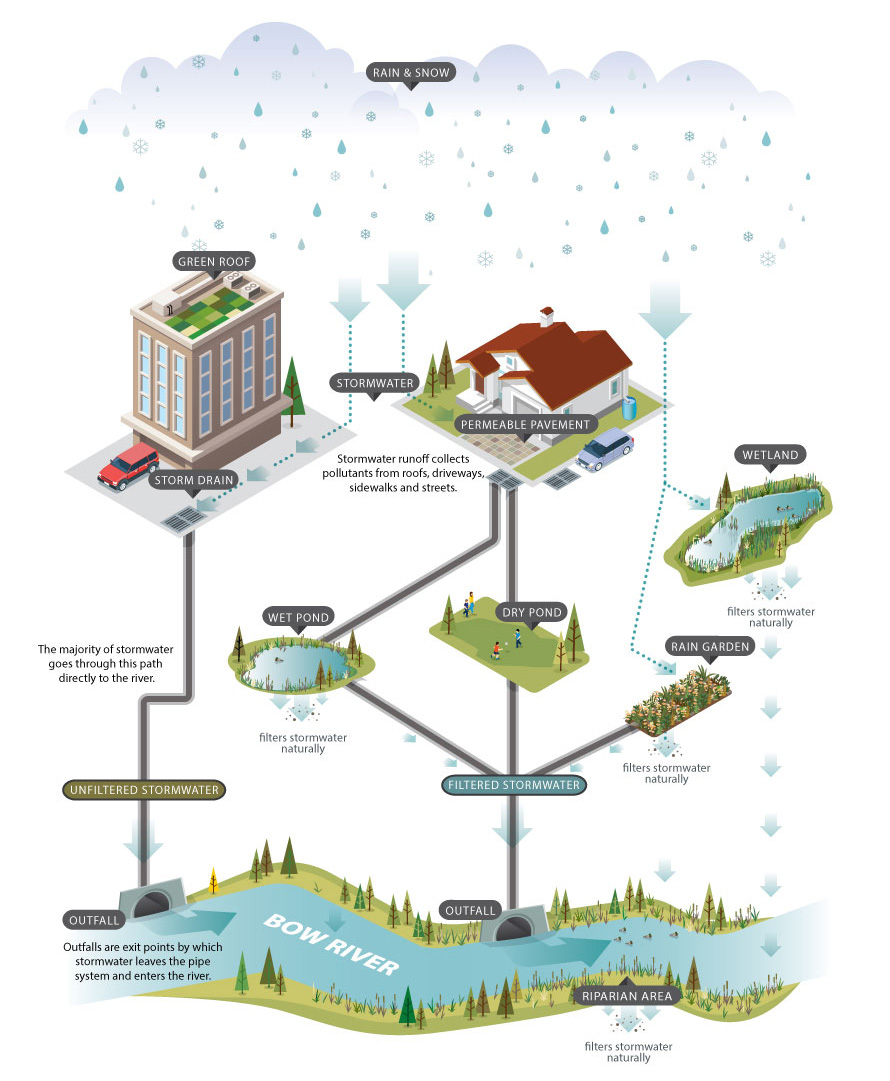Stormwater management
What is stormwater
When it rains, or snow melts, water runs off our streets, driveways, and yards and ultimately ends up in our rivers and creeks. This runoff is called stormwater.
Stormwater picks up garbage, chemicals, pet waste, salt, fertilizers, dirt and other debris, all of which also end up polluting our rivers and creeks.
Stormwater can affect the health of our creeks, rivers, wetlands and the land surrounding them, as well as the health of the wildlife and fish that rely on them.
Click image for a full-size version
How you can protect our stormwater system
Dirt, litter, automotive fluids, pet waste and chemicals such as fertilizers and pesticides can be washed into storm drains which are connected to the underground pipe system.
This can affect the health of our streams, rivers and the land surrounding them, as well as the health of the wildlife and fish that rely on them, so we need to ensure the water draining into it is clean.
We need to take collective responsibility for managing our stormwater and ensuring our rivers and streambanks.
Here's how you can do your part:

Never pour anything down the storm drain
It is an offence under the stormwater bylaw to allow any prohibited material to enter the stormwater system.
Some examples of prohibited materials are:
- Soil
- Sediment
- Cooking oils/grease
- Water from hot tubs/pools
- Soaps/Detergents
- Gasoline
- Motor oil
- Solvents
- Paint
- Pesticides, herbicides or fertilizers
- Construction materials including sawdust and drywall mud
- Grass or hedge clippings
- Transmission fluid
- Antifreeze
- Cement or concrete waste
- Hazardous substances
- Litter or general trash
For more information on where to dispose of household hazardous waste:

Wash your vehicle at a car wash
- Under the Stormwater Bylaw 37M2005, if you are washing your car on the street, you must not use any kind of soap or any product other than water, and your car must not be overly dirty.
- When you wash your car, the rinse water may contain harmful pollutants including oil, grease and soap.
- Commercial car washes drain to the City’s wastewater treatment facility where the wastewater is cleaned and treated.

Use a rain barrel
By capturing rainwater before it hits the ground, rain barrels play a vital role in reducing stormwater runoff.
This helps to prevent soil erosion and keeps pollutants from being washed into our waterways.

Replace your lawn with a YardSmart Yard
Wherever possible, replace portions of your lawn with tiered gardens, rock gardens, low water-use shrubs or flowering trees and groundcover.
These garden features use less water and act as wonderful filters and sponges to help absorb rainwater.

Pick up after your pets at home and elsewhere
When pet waste is left on the ground, it can be carried into our rivers and creeks via the stormwater system.

Point downspouts toward lawns and gardens
Ensure your downspouts all drain into an area where water can be soaked up (like a nearby lawn or garden).

Properly dispose of litter
- Cigarette butts, plastic bottles and food wrappers are common litter found along and, in our rivers, and creeks.
- Litter can affect water quality and endanger plant and animal life.
Interested in doing more?

Limit the use fertilizers and pesticides
Pesticides can be toxic to aquatic ecosystems.
For more information on alternatives to pesticides and fertilizers for a pest free garden:

Check for and repair automotive spills and leaks
- Check your vehicle for leaks regularly
- Use a drop cloth and drip pans when doing work on your vehicle
- Do not pour automotive fluids down the storm drain. Dispose of products appropriately.
- Oil and petroleum products are toxic to wildlife and plants and negatively affect water quality.
Stormwater management
Calgary is a growing city on two small rivers. In the face of a changing climate that brings shifting precipitation patterns, earlier snowmelt and higher intensity storms, our approach to how we collect, store and release stormwater is evolving to keep new and older communities safe while protecting the natural environment and our rivers healthy.
Managing stormwater reduces the impact of flooding, ensures public safety, reduces damage to property and helps keep our rivers healthy. The practices below improve the quality and decrease the volume of stormwater entering our waterways.
Storm drains
Storm drains (or catch basins) are the main way stormwater gets into the underground pipe system. There are about 60,000 storm drains in Calgary which drain water off sidewalks, streets and roads.
The metal grates that can be seen at the edge of the road are only a portion of the catch basin structure. Under the sidewalk is a barrel that collects water.
The barrel is attached to a pipe that allows the water to be whisked away, eventually into our rivers. These pipes start out small and get larger the closer you are to the river. They direct stormwater to the river via gravity.
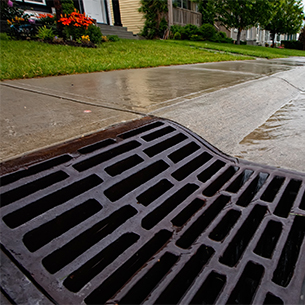
Wet ponds
Wet ponds hold water all of the time. These ponds are designed to capture and hold stormwater – for a while.
Wet ponds slow down water long enough to settle out some of the sediments and pollutants, helping return cleaner water to our rivers and streams through the stormwater system.
There are over 200 wet ponds throughout the city.
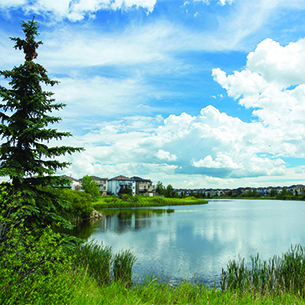
Dry ponds
A dry pond is dry most of the time and may have playing fields in it. During heavy rains, dry ponds will fill with water very quickly.
This prevents the stormwater system from becoming overwhelmed. This helps to prevent water from backing up into basements or flooding into houses or businesses.
Dry ponds are connected to stormwater infrastructure and can take as long as 24 hours to drain once the rain stops. There are over 100 dry ponds throughout the city.

Low impact development
Low Impact Development (LID) is an approach to land development that works with nature to manage stormwater runoff where it falls. LID preserves and recreates natural landscape features. It also minimizes hard surfaces to create functional and appealing site drainage.
LID includes a variety of landscaping and design practices to slow water down, spread it out and soak it in. These practices ultimately improve the quality, and decrease the volume, of stormwater entering our waterways.
For more information on LID best management practices, including rain gardens, green roofs and permeable pavement, visit Low Impact Development (calgary.ca)

Wetlands
A wetland is an area of land that is saturated with water either permanently or seasonally. It contains plants and the water is quite shallow before a storm.
Natural wetlands are not directly connected to Calgary’s stormwater system.
Constructed stormwater wetlands are closely related to wet ponds but are more shallow and tend to have more vegetation cover.

Outfalls
Outfalls are the exit points by which storm water leaves the pipe system and enters our rivers or creeks. There are more than 800 outfalls located across Calgary.
In winter, ice can build up and force water from the rivers or creeks, and into the storm mains and surrounding communities. The outfall gates prevent this from happening. The gates are closed and monitored daily during winter months (November to April) because the ice pack on the rivers can change dramatically in a short period of time. If the level of stormwater is significant, the gates are opened, and the water is released. The gates are then immediately closed again.
During summer months (May to October), the gates are fully open; however, they are monitored during this time and closed during high river flows to prevent water flowing back into the community.
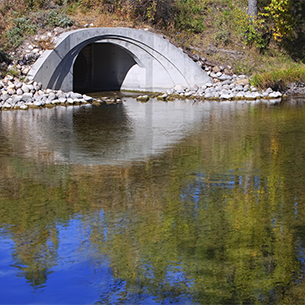
Stormwater management strategy
The City of Calgary promotes healthy, resilient communities and waterbodies through proactive and collaborative stormwater management.
The updated Stormwater Management Strategy sets out a long-term direction over the next 20 years for new and innovative ways for managing stormwater runoff, improving water quality and decreasing pressure on the stormwater system. This strategy will inform investments and decision-making as we continue to maintain, build and plan for a growing city.
We will be collaborating with partners, developers, watershed experts and Calgarians on how best to deliver innovative and effective stormwater solutions across the city as we move forward.
Goals and outcomes
-
Create safe and vibrant neighbourhoods
while striving for equitable service for all Calgarians.
-
Share responsibilities with Calgarians
and with surrounding regions for being good stewards of our communities and environment.
-
Promote and attain
healthy and resilient watersheds.
-
Provide infrastructure and services
that maximize value for Calgarians.
Cornerstones to achieve goals
Stormwater strategy
Homeowner stormwater guide
Download our Homeowner Water Guide for Calgary's stormwater management system.
Translated versions:
Stormwater bylaws
Our stormwater bylaws ensure proper water use and drainage from your home or business to The City’s stormwater system.


